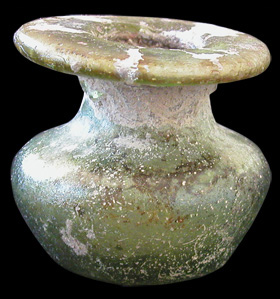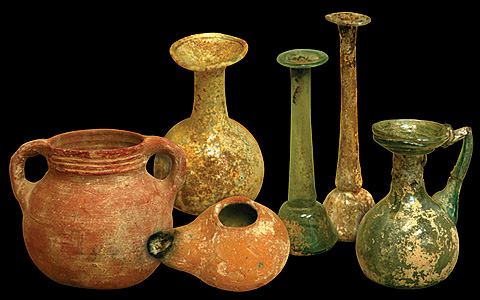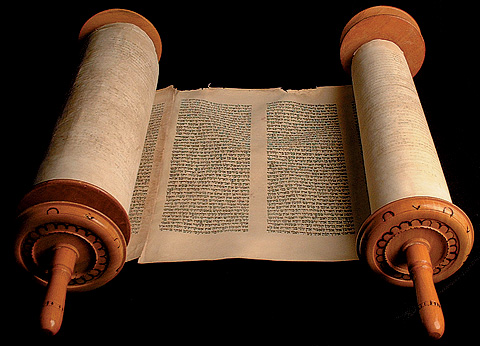Dead Sea Scrolls

Dead Sea Scroll Genesis Midrash Fragment
2nd-1st Century B.C.
Translation:
“Then God said to Abraham…So Abraham instructed Isaac, his son, ‘Take the ram…’ Then an angel of the Lord prohibited Abraham from sacrificing his son…”

Dead Sea Scroll Isaiah Fragment
2nd-1st Century B.C.Translation:
“From the ends of the earth we have heard songs, ‘Glory to the righteous ones!’ But I said, ‘I am ruined, I am ruined! Woe to me! The treacherous ones have dealt treacherously, indeed the treacherous ones have dealt extremely treacherously.’ Fear and the pit and the snare are upon you, O inhabitant of the earth.”
Words in bold are words found on the fragment.
Research on fragments by:
1) Professor James H. Charlesworth
Princeton Theological Seminary, Princeton, New Jersey
2) Professor Hanan Eshel
Bar-Ilan University, Tel Aviv, Israel
3) Professor Emile Puech
Ecole Biblique, Jerusalem, Israel

Dead Sea Scroll Deuteronomy Fragment
1st Century B.C.Translation:
“…An Ammonite and Moabite shall not enter the assembly of the Lord; even the tenth generation of his descendants shall not enter the assembly of the Lord forever, because they did not meet you with bread and water on the way when you came out of Egypt, and because they hired against you Balaam, the son of Beor from Pethor of Mesopotamia, to curse you…”
Words in bold are words found on the fragment.
Research on fragments by:
1) Professor James H. Charlesworth
Princeton Theological Seminary, Princeton, New Jersey
2) Professor Hanan Eshel
Bar-Ilan University, Tel Aviv, Israel
3) Professor Emile Puech
Ecole Biblique, Jerusalem, Israel

Dead Sea Scroll Jeremiah Fragment
1st Century B.C.Translation:
“’We have heard the pride of Moab. He is exceedingly proud, of his loftiness and pride and arrogance, and of the haughtiness of his heart.’ ‘I know his wrath,’ says the Lord, ‘but it is not right; his lies have made nothing right. Therefore I will wail for Moab, and I will cry out for all Moab…’”
Words in bold are words found on the fragment.
Research on fragments by:
1) Professor James H. Charlesworth
Princeton Theological Seminary, Princeton, New Jersey
2) Professor Hanan Eshel
Bar-Ilan University, Tel Aviv, Israel
3) Professor Emile Puech
Ecole Biblique, Jerusalem, Israel

Pottery Ink Well

Glass Ink Well

Pottery Ink Well

Pottery Ink Well

Entire contents of a 1st century B.C. Cave from Qumran, Israel
The Qumran caves preserved artifacts from many periods; most artifacts were from c.200 B.C. to 68 A.D.
These 31 artifacts are the entire contents of a cave from the same period and location as the 11 Qumran caves that contained scrolls (with the exception of the 3 ceramic containers which date from Iron Age II). All are typical of Jerusalem and its environs. The light green hue of most of the glass is due to the metal oxides in the material from the area. This cave or tomb dates to the 1st century B.C. (the date of the major manuscript “The Rule of the Community.”)
3 Ceramic Containers*
Iron Age II
1000-586 B.C.
Qumran, Israel9 Ceramic Oil Lamps
Hasmonean Kingdom
150-63 B.C.
Qumran, Israel
Late Hellenistic
1st century B.C.
Qumran, IsraelCeramic Oil Lamp
Herodian Period
c.30 B.C.
Qumran, Israel
4 Glass Containers
Roman
2nd-1st century B.C.
Qumran, Israel3 Glass Containers with Handle
Roman
2nd-1st century B.C.
Qumran, IsraelGlass Container (Broken)
Roman
2nd-1st century B.C.
Qumran, Israel4 Glass “Tear Drop” Bottles
Roman
2nd-1st century B.C.
Qumran, IsraelUnguentarium Glass Container
Roman
2nd-1st century B.C.
Qumran, Israel2 Hand Blown Glass Containers
Roman
2nd-1st century B.C.
Qumran, Israel* These Ceramic Containers from Iron Age II date to a period significantly earlier than the time period of the cave in which they were found. Other scholarship on the period and region suggest that vessels such as this may have been kept as precious antiques.

Large Torah Scroll Fragment

